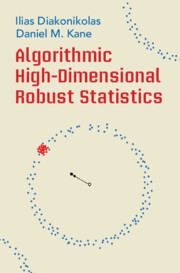Refine search
Actions for selected content:
2327 results in Pattern Recognition and Machine Learning
Preface
-
- Book:
- Adversarial Learning and Secure AI
- Published online:
- 07 September 2023
- Print publication:
- 31 August 2023, pp xiii-xvi
-
- Chapter
- Export citation
1 - Overview of Adversarial Learning
-
- Book:
- Adversarial Learning and Secure AI
- Published online:
- 07 September 2023
- Print publication:
- 31 August 2023, pp 1-18
-
- Chapter
- Export citation
5 - Backdoors and Before/During Training Defenses
-
- Book:
- Adversarial Learning and Secure AI
- Published online:
- 07 September 2023
- Print publication:
- 31 August 2023, pp 116-140
-
- Chapter
- Export citation
12 - Robust Deep Regression and Active Learning
-
- Book:
- Adversarial Learning and Secure AI
- Published online:
- 07 September 2023
- Print publication:
- 31 August 2023, pp 281-293
-
- Chapter
- Export citation
9 - Universal Post-Training (PT) Backdoor Defenses
-
- Book:
- Adversarial Learning and Secure AI
- Published online:
- 07 September 2023
- Print publication:
- 31 August 2023, pp 226-245
-
- Chapter
- Export citation
6 - Post-Training Reverse-Engineering Defense (PT-RED) Against Imperceptible Backdoors
-
- Book:
- Adversarial Learning and Secure AI
- Published online:
- 07 September 2023
- Print publication:
- 31 August 2023, pp 141-184
-
- Chapter
- Export citation
Contents
-
- Book:
- Adversarial Learning and Secure AI
- Published online:
- 07 September 2023
- Print publication:
- 31 August 2023, pp vii-xii
-
- Chapter
- Export citation
7 - Post-Training Reverse-Engineering Defense (PT-RED) Against Patch-Incorporated Backdoors
-
- Book:
- Adversarial Learning and Secure AI
- Published online:
- 07 September 2023
- Print publication:
- 31 August 2023, pp 185-210
-
- Chapter
- Export citation
2 - Deep Learning Background
-
- Book:
- Adversarial Learning and Secure AI
- Published online:
- 07 September 2023
- Print publication:
- 31 August 2023, pp 19-55
-
- Chapter
- Export citation
8 - Transfer Post-Training Reverse-Engineering Defense (T-PT-RED) Against Backdoors
-
- Book:
- Adversarial Learning and Secure AI
- Published online:
- 07 September 2023
- Print publication:
- 31 August 2023, pp 211-225
-
- Chapter
- Export citation
Copyright page
-
- Book:
- Adversarial Learning and Secure AI
- Published online:
- 07 September 2023
- Print publication:
- 31 August 2023, pp iv-iv
-
- Chapter
- Export citation
References
-
- Book:
- Adversarial Learning and Secure AI
- Published online:
- 07 September 2023
- Print publication:
- 31 August 2023, pp 333-350
-
- Chapter
- Export citation
Index
-
- Book:
- Adversarial Learning and Secure AI
- Published online:
- 07 September 2023
- Print publication:
- 31 August 2023, pp 351-354
-
- Chapter
- Export citation
Appendix - Support Vector Machines (SVMs)
-
- Book:
- Adversarial Learning and Secure AI
- Published online:
- 07 September 2023
- Print publication:
- 31 August 2023, pp 322-332
-
- Chapter
- Export citation
10 - Test-Time Detection of Backdoor Triggers
-
- Book:
- Adversarial Learning and Secure AI
- Published online:
- 07 September 2023
- Print publication:
- 31 August 2023, pp 246-255
-
- Chapter
- Export citation
Notation
-
- Book:
- Adversarial Learning and Secure AI
- Published online:
- 07 September 2023
- Print publication:
- 31 August 2023, pp xvii-xx
-
- Chapter
- Export citation
11 - Backdoors for 3D Point Cloud (PC) Classifiers
-
- Book:
- Adversarial Learning and Secure AI
- Published online:
- 07 September 2023
- Print publication:
- 31 August 2023, pp 256-280
-
- Chapter
- Export citation
Reviews
-
- Book:
- Adversarial Learning and Secure AI
- Published online:
- 07 September 2023
- Print publication:
- 31 August 2023, pp ii-ii
-
- Chapter
- Export citation
14 - Reverse-Engineering Attacks (REAs) on Classifiers
-
- Book:
- Adversarial Learning and Secure AI
- Published online:
- 07 September 2023
- Print publication:
- 31 August 2023, pp 315-321
-
- Chapter
- Export citation

Algorithmic High-Dimensional Robust Statistics
-
- Published online:
- 24 August 2023
- Print publication:
- 07 September 2023
